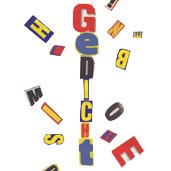Für eine erweiterte historische und / oder akademische Abhandlung schauen sie sich meinen Artikel über Typographic Foregrounding, veröffentlicht in Language and Literature 2, Nr.1, 1993, pp 49-61, in welchem ich solche Formen der Lyrik, wie sie in der konkreten Poesie vorkommen, als eine Art foregrounding darstelle. Das geht zurück auf eine wirklich interessante Literaturtheorie, zuerst entwickelt von den Russischen Formalisten um das Jahr 1917. Unter anderem haben sie sich die Frage gestellt, wofür Kunst und Literatur an erster Stelle seien. Viktor Sklovskij, einer ihrer eminenten Repräsentanten druckt es aus wie folgt:
And art exists that one may recover the sensation of life, it exists to make one feel things, to make the stone stony. The purpose of art is to impart the sensation of things as they are perceived and not as they are known. The technique of art is to make objects ‘unfamiliar,’ to make forms difficult, to increase the difficulty and length of perception because the process of perception is an aesthetic end in itself and must be prolonged.
Das ist ein Zitat aus seinem berühmten Essay „Iskusstov kak priem“, 1917, erschienen in englischer Übersetzung „Art as Technique“ (p. 12), zu finden in Foregrounding by W. van Peer & Frank Hakemulder, The Pergamon Enciclopaedia of Language and Linguistics, ed. Keth Brown, Oxford: Elsevier, 2006, Band 4, pp 546-551.
Ich sollte aber nicht so sehr auf die Theorie eingehen, denn eine der attraktivsten Seiten dieses Blogs ist eben, dass hier nicht über Literatur geschrieben, sondern Literatur produziert wird.
If there is any interest for a more historical and / or academic approach, I have written an article on ‘Typographic Foregrounding’, published in Language and Literature 2, no. 1, 1993, pp. 49-61. In it I consider such forms as are used in concrete poetry as a kind of ‘foregrounding’. This concerns one of the really interesting literary theories, developed first by the Russian Formalists around 1917. What they did, among other things, is to ask themselves what art and literature are for in the first place. In the words of Viktor Shklovsky, one of its most eminent representatives:
And art exists that one may recover the sensation of life, it exists to make one feel things, to make the stone stony. The purpose of art is to impart the sensation of things as they are perceived and not as they are known. The technique of art is to make objects ‘unfamiliar,’ to make forms difficult, to increase the difficulty and length of perception because the process of perception is an aesthetic end in itself and must be prolonged.
This is from his famous 1917 essay “Iskusstov kak priem”, here in the English translation “Art as Technique”, p. 12. In case anyone is interested in this approach, please refer to: W. Van Peer & Frank Hakemulder: Foregrounding in The Pergamon Encyclopaedia of Language and Linguisitics, ed. Keith Brown, Oxford: Elsevier, 2006, vol. 4, pp. 546-551.
But let me not go on about theory. One of the most attractive sides of this blog is that it is not about literature. It is literature!
